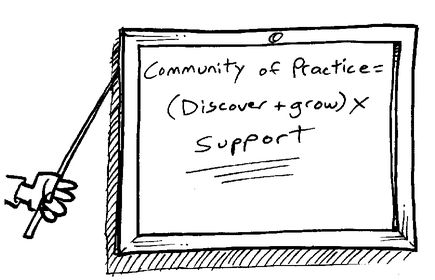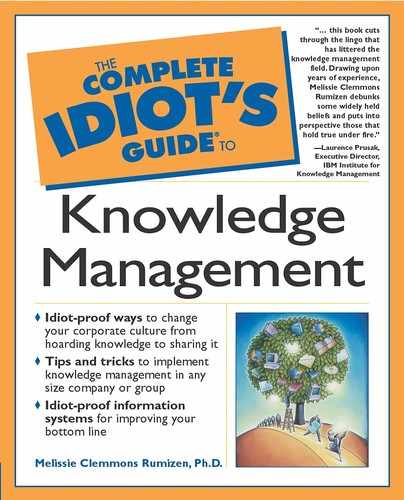
Chapter 8
Communities of Practice—The Killer Application
In This Chapter
▶ Characteristics of communities of practice
▶ Role of the community coordinator
▶ Launching a community of practice at SAP America
I dare you to find a serious general conference on knowledge management that doesn’t include at least one session on communities of practice. Slowly over the past few years, communities of practice have come to be acknowledged as the killer application for knowledge management. And rightfully so.
But the concept may be hard for you to grasp. I’ll admit that to someone who has spent years in organizational life, communities of practice look weird. They don’t look anything like the teams you were on. Are they supposed to replace the standard organizational structures? If so, how? Will people belong to communities of practice, and teams, and departments?
In this chapter, we’ll learn more about that elusive creature, the community of practice, and its distinguishing characteristics. We’ll discuss the creature’s life cycle and how to nurture it. Lastly we will discuss how to bring them into the world.
The Platypus of Organizational Structures
A community of practice (COP) is a platypus lurking among the dogs, chickens, cows, and pigs of standard organizational structures. I say that because when I began to understand what a community of practice is, I was reminded of the day in grade school when we learned about the platypus. Having been told up until then that all mammals bore living young, I thought the platypus was odd because it laid eggs. The picture in our textbook didn’t help much. It reminded me of a cross between a duck, a beaver, and a seal. In real life, the platypus is a shy and wary animal. It lives in burrows on the banks of freshwater ponds in eastern Australia and Tasmania, venturing out in the early morning and night to feed.
In organizational life, communities of practice can also be shy and wary. Nevertheless, they may surround you. You just need to know where and what to look for. You may even be one yourself—many of us are, even though we’re not aware of it. Also, more organizations are recognizing and supporting these rare animals, so they’re getting easier to spot.

Know How
Etienne Wenger is credited with creating the term “community of practice” (although he gives the credit to his former colleague Jean Laval). Etienne believes that learning is a social activity and that people learn in groups. He practices what he preaches, working and learning with Richard McDermott and Bill Snyder. The three will publish a pragmatic, how-to guide on the subject, Cultivating Communities of Practice (Harvard University Press, 2002). It’s the best source to learn more about this concept.
At first you may be tempted to think that communities of practice are another type of team. However, they aren’t teams—but there can be teams within a community of practice. Although teams vary, they have some common characteristics:
▶ Usually formed by management, teams focus on a discrete goal or a series of discrete goals.
▶ Team members are usually draftees—they are requested by management to be a part of the team.
▶ Usually they are multifunctional, as the collaboration of team members with different skills is required to achieve the goals.
▶ They often produce orderly charts laying out the timeline needed to achieve their goals and the milestones along the way.
▶ When the team achieves its goals, it disbands.
You also might be tempted to think that communities of practice are like the work groups you’ve belonged to all of your organizational life. If so, you’re wrong. Communities of practice aren’t work groups, either. Work groups
▶ Are assigned by management to perform a particular function, such as the manufacture of a product or delivery of a service.
▶ Are composed of members with the various skills needed to carry out the work group’s task.
▶ Have objectives that are ongoing with discrete deliverables.
▶ Last until reorganized or disbanded.
In contrast, a community of practice has its own characteristics—its equivalent of the duckbill, webbed feet, and egg-laying traits of the platypus:
▶ In almost all organizations, a community of practice is made up of volunteers. No one forces the members to belong or contribute.
▶ While community members learn and work together, they don’t necessarily produce deliverables or operate within defined schedules and timetables.
▶ They are distinguished by their passion for what brings them together.
▶ While they may have some stated goals, they are broader and more general than the goals of work groups and teams. Their goals also may fluctuate more.
▶ Their members tend to be like each other, perhaps with the same types of jobs and skills or some other common interest or bond.
▶ They last as long as the members want them to last.
This last quality, the ability for self-sustainment, is what drew me to communities of practice. As a benchmarking manager, I was active with teams and work groups, promoting both learning and sharing of knowledge. I was happy with the immediate results most of the time. What frustrated me, though, was that the learning and sharing often stopped when the benchmarking stopped. I wanted to see the sharing and learning be more than a one-time shot.

Know Nos
Communities of practice remind me of the adage that you can lead a horse to water but you can’t make it drink. I would change that for communities of practice to add that you can’t even necessarily lead this horse to water. Don’t assume you can dictate to a community of practice like you can a team or work group. They are volunteers for the most part, not draftees.

Know How
I once was involved in a community of practice effort that had mixed results. I was later told that the members felt that the group didn’t “do any real work.” Since then, doing “real work” has been my earmark for the practice.
The Three Dimensions of a Community of Practice
A community of practice is a group of practitioners who share a common interest in a specific area of competence and are willing to work together. A community of practice has three dimensions:
▶ What the members care about, their area of interest. This is the domain of knowledge for the community. It may be a skill like equipment repair, a professional discipline such as an engineering specialty, or a topic like creativity. 3M, for example, has a long-standing community around creativity. Whatever the commonality, it must be focused and defined well enough so that people identify with it. They must also have a passion for it. This passion for the area of interest is the catalyst that draws people together.

Know Nos
Never underestimate the importance of social activities. Such activities aren’t wasted time that could be better spent on actual work. Social activities help build the interpersonal relationships that enable a community to do real work. But at the same time, social activities should be structured so that they meet the goals of building a community. They should allow people to connect with those they already know as well as new people. You can set up luncheons for small groups, arrange for members to meet each other for coffee, and set aside time at larger meetings for people to meet each other and talk.
▶ Who the members of the community are. Any community is an intricate web of personal relationships. People within a community know and trust each other. They do things together. Some of these are social in nature; others are work activities.
▶ How the community does its work. This is the practice. As a community works together on their domain, they create tools, documents, processes, a common vocabulary, and shared ways of doing their work. Many communities solve problems that arise in the day-to-day work. Many develop and document best practices, the best way of doing things.
The Life Cycle of the Community Platypus
Think of a community of practice as a living organism. An organism, like the platypus, is born, grows, matures, and dies. Richard McDermott, Bill Snyder, and Etienne Wenger (McDermott, Knowledge Management Review, “Community Development as a Natural Step,” November/December 2000) have defined five stages of potential development of a community of practice.
Planning
At this egg-like stage there are people in a loose network who have similar interests, capabilities, and needs. However, they may not see any value in doing any more work on the network. What they have is good enough for them, and, besides that, they have never seen anything like a community of practice. You need to find those people and talk to them. Part of the dialogue centers on the need for a community; another critical part is on beginning to define the domain of knowledge they share. Management must be engaged, for it will provide the resources required. It also can help remove organizational barriers.
Start-Up
Some communities launch with a big bang. Others ease into existence with low-key informal sharing. A problem for the members at this stage is that they must learn what they can do together: what to share, what is useful, and how to work together. It takes time to develop relationships as well. This can be discouraging, drowning an initial burst of enthusiasm.
There is a dilemma at this point: Members need value to stay in the community, but the community needs time to deliver value. Management also needs to see a return on its investment.
Growth
Good things are happening: Good work is being done, relationships are expanding and deepening, and the community itself is becoming more visible. However, as the new community adds members, the addition of those members can be disruptive. Care must be taken to handle the expansion well.
Sustainment
Sounds like the community is on easy street at this point, doesn’t it? However, in this stage the community must dance the tightrope of sustaining itself and continuing to grow. Without continual growth, the community can stagnate.
It is also important to sustain the heartbeat of the community. Although every community has its highs and lows, a prolonged low could trail off into the last step: closure.
Closure
Like the notes of a bugle blowing taps, a community can fade away or the practice can disappear, leaving behind a well-connected social club.
Sometimes the best thing to do is to pronounce death, have a lovely funeral to celebrate the community’s life, and help the members to move on.

Know How
Being a community coordinator takes time. Usually, the minimum amount of time needed to support a community is 15 percent of a person’s work time. Percentages between 15 percent and 25 percent aren’t unusual. It could even be higher when starting a community. There also is a correlation to size, with larger communities such as those in the thousands requiring more time.
The Most Important Member, the Community Coordinator
The most important critical success factor for a community of practice is having an effective community coordinator. While the rest of the community has a passion for what they do, the coordinator also must have a passion for the people in the community. He or she has two jobs:
▶ Help the community to develop the practice
▶ Help the community develop as a community
Helping the Community to Develop the Practice
While the individual members are busily engaged in the practice, the community coordinator monitors the big picture. There may be gaps the community needs to fill. There may be tools and other resources that the community needs. There may be cutting-edge issues the community needs to address. It’s the community coordinator’s job to help oversee the practice and help get the community members what they need.
Helping the Community Develop as a Community
On one level, the community coordinator is somewhat like a recreation director. This person should schedule events that enable the community to meet and interact. Although around 70 percent of the activity in any community occurs in the private interaction between individual members, events that bring the whole group together do have impact. Events are important for the life cycle of the community. Events such as a meeting to charter a community or a conference can spark the initial development or help a community sustain momentum. If necessary, an event can mark the closure of a community.
Taking care of event logistics isn’t all that a community coordinator does. Prior to the actual event, the coordinator talks to members,
▶ Coaxing some to come.
▶ Telling others that a topic of particular personal interest will be covered.
▶ Asking some to make specific contributions during the event.
▶ Suggesting that certain people meet each other at the event.
During an event the coordinator may take notes, making it easier for the members to participate. Afterward the community coordinator follows up on suggestions and may post notes or documents from the event.
Of course, judging when to have an event is another important task for a coordinator. The community coordinator must watch what is going on in a community, particularly when community activity begins to die down. Usually, at such a time, an event is an ideal spark to rekindle interest.

Know Nos
When talking to an MBA class once, I was asked how to deliberately end a community. The question stunned me. Questions usually hone in on how to nurture, not how to stop. But the answer was easy. The most effective way is to remove the community coordinator. So remember: Don’t decide that a community no longer needs a coordinator. Don’t let a coordinator leave without a replacement unless the community decides that is all right.
Although events are exciting, regular forums for exchange also are important. Most communities have an active discussion area where they solve problems together and share information, often online community coordinators often serve as facilitators for such forums, making sure that questions get answered and monitoring the interactions.

Know How
I myself am a member of a community on communities of practice (groups.yahoo.com/ group/com-prac). John Smith is our community coordinator. One way John keeps up with the ebb and flow of the group’s activity is by tracking the number of messages per month. This chart of activity is also available on the home page. The number of members also is posted. When the community reached a size of more than 300, John felt it was time to review the purpose of the group. He posted a charter for all of us to read. This was a canny move on John’s part, an experienced and capable coordinator who knows when to prod a community.
An important subgroup for any community is its new members. Bringing them on board may or may not be a role for the community coordinator. However, there needs to be a process for welcoming them to the group, giving a little of the history of the group, and teaching them the basics of the community. At the very least the community coordinator should make sure this process is being carried out and also personally welcome new members if possible.

Didn’t Know
Organizations vary in how they pick community coordinators. At Schlumberger, communities of practice elect their own leaders. However, Schlumberger has learned that revered seniors make lousy leaders, as awe paralyzes the members. The best candidates have about three years of experience, a lot of smarts, and want to get to know other people. Most of all, they are too new to have big egos.
The most important role, though, for the community coordinator in building the community is networker par excellence. The community coordinator must have a widespread personal network. Ideally, his or her personal network should extend beyond the community itself. Inside the community, he or she is the primary member of the community that everyone knows and respects. The coordinator, using network skills, helps to connect community members to each other. The more members who feel a connection to each other, the stronger the community. A successful community coordinator makes building those connections a priority. And since 70 percent of the activity that occurs in a community takes place privately between individuals, the more people who know each other, the more knowledge can be shared.
Launching a Community of Practice at SAP America
There’s a lot to think about when launching a community of practice. We will look at a case study from SAP America to illustrate some basic principles.
SAP America had a challenge. A competitor had come out with a product that quickly had captured a big chunk of market share. SAP’s lack of market share meant that it lacked enough customers to give the company a reference (customers who would vouch for SAP’s product), a key in getting more customers and thus increasing market share. One thing SAP had to do in order to win back the market was make sure its consultants (the people who worked with clients) had the best and latest information possible on SAP’s offerings.
Laying the Foundation
SAP America carefully planned, launched ,and supported their community of practice effort. They began by
▶ Creating a business case for the community of practice. Managers pointed out that the most up-to-date information was not getting out to the field. This put the consultants at a disadvantage, adversely affecting customer service.
▶ Identifying an initial leader for the community. SAP got someone full-time for three months and then groomed him on the importance of knowledge management and communities of practice.
▶ Defining the scope of the community. The company focused on customer-implementation projects. It then identified all of the organizations and experts that supported the community members.

Know How
The domain for a community of practice is going to change over time. Plan on it, and plan on helping the community to evolve the domain. This might cause major upheaval, with large chunks of members leaving as the domain alters. That’s OK, if it is for the overall betterment of the community. How to develop the domain is the community’s decision. It has the expertise.
▶ Designing the core activities. SAP decided on a series of one-hour conference calls to be held biweekly. Each call had a carrot in the first 20 minutes—an expert, a hot topic, etc. Also, the community was tied into all training events, conducting a little community business during training and capitalizing on the face-to-face time. 


Didn’t Know
When making a business case for communities, look at three aspects:
▶ For individuals, the payoff is help in doing their jobs, a sense of belonging, a chance for learning and development, and new challenges.
▶ For a community, the payoff is increasing access to expertise, providing a means to share knowledge, and helping to build tools, documents, and processes for the practice.
▶ For an organization, communities of practice pay off by helping to drive strategy, transferring knowledge and best practices, building core capabilities, and increasing innovation.

Know How
Another important supporting role for a community is a librarian. A librarian can find, organize, post, and otherwise manage information. This frees up the community coordinator to build connections and develop the practice, while also drawing upon the specialized skills of a library to manage information. You may also find librarians maintaining databases and Web sites for communities.
▶ Recruiting and engaging core members. SAP picked out around 10-15 people who were passionate about sharing knowledge. They also made sure that this group represented all parts of the organization.
▶ Aligning with current culture. The experts were eager to share; the community provided a means for sharing. They also scheduled the conference calls so that they didn’t conflict with customer projects.
▶ Designing roles for the community of practice. These roles included a shared leadership role among a consultant, an expert, and a respected senior member in the community.
▶ Developing a support structure of both information technology and people. The intranet site for the community of practice included a community calendar, a who’s who, sources of information, and a discussion area. Additionally, the site has a repository of resources like white papers, how-tos, and project information.

Didn’t Know
Communities of practice also can start themselves. One example is within the American Red Cross. One year, local chapters that provide transportation attended a conference on community transportation. While at the meeting they met separately to discuss their local programs. They shared and learned together as a group. They followed up with conference calls. Later, they formed an e-mail group for those who were interested. As the yearly meeting is one they all usually attend, they plan to continue meeting face-to-face then.
Liftoff for the Community
SAP America kicked off the community with their planned community event, the biweekly conference call. The events also were carefully staged, with scripted first calls. Despite the script, however, spontaneity was allowed and encouraged. A facilitator also assisted in the group interaction. Although SAP America limited original participation in the community event, participation soon tripled. The benefits to SAP America from this community were and continue to be
▶ Reduced costs.
▶ Improved quality.
▶ Improved innovation.
▶ Improved transfer of knowledge.
▶ Increased value to the customers.
For the individuals in the community, the similar benefits are
▶ Faster learning.
▶ Collaborative innovation.
▶ Better networking.
▶ Less time looking for information.
▶ More information available for consideration.
▶ Greater sense of connection with peers.

Didn’t Know
An organizational support team for communities of practice can provide direct community support: training community coordinators, developing tools and tips, and monitoring community health. Another important task is linking communities of practice to the organization itself. Community development must be integrated with the strategy of the organization. Apart from the hustle and bustle of daily community life, a support team can attend to the global strategy.
As this example shows, although it does require planning and considerable effort to launch a community of practice, the benefits are numerous. That’s why it is the killer application of KM. While no one approach is right for every organization, nothing else comes as close.
The Least You Need to Know
▶ Communities of practice are a newly recognized organizational structure, not another type of team or work group.
▶ Communities of practice have three dimensions: the domain, the community, and the practice.
▶ Communities of practice have a life cycle.
▶ The most important critical success factor for a community is the community coordinator.
..................Content has been hidden....................
You can't read the all page of ebook, please click here login for view all page.
